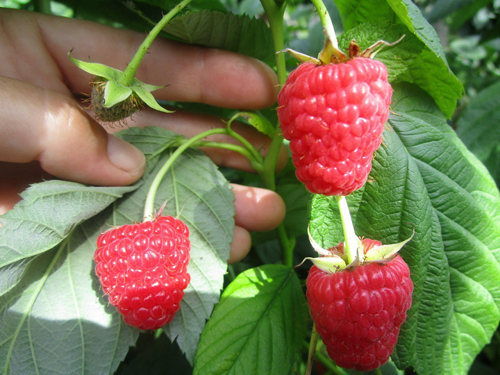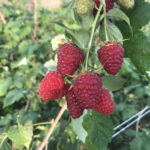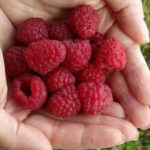Raspberry variety Maravilla
Repaired raspberry varieties, which give two full harvests per season, in the early stages - on two-year shoots, and in mid-late summer - on annuals, are called buttimers. One of these is Driscoll Maravilla (Driscoll Maravilla) or simply Maravilla. Also common names are Marabella, Marichka.

Her "parents" were crossed in 1996, and the best of the resulting plants were selected from an experimental planting in 1998 in Watsonville, California (where Driscoll is headquartered). Further propagation was carried out in the laboratory by the in-vitro method (in vitro). A patent for a new remontant in the United States was obtained in 2004.
Until recently, this raspberry on the territory of Ukraine, Russia, Belarus was covered with an aura of mystery and enigma, was something unattainable, but very desirable. A dream for both many ordinary summer residents and large farmers. But now Maravilla seedlings appear in rather large quantities in our markets, and the plantings themselves sometimes take 3-4 years, but there are debates about the variety, cultivation methods, differences in agricultural technology
The fact is that the bulk of the varieties belonging to the Driscoll firm are closed and closely guarded club specimens, which can be grown and sold only with a license, and only Driscoll's have the right to sell seedlings.

Before buying seedlings, the owner of the growing license indicates in the contract that the berry plantation can only be used for 3 years, after which it is grubbed, and the plants that have spent their resource are disposed of. But in some cases, by agreement with the company, it is possible to increase the service life up to 4-6 years. And grubbed bushes, for example, were secretly sold to us in the form of a mother root for further reproduction. This is approximately how the first specimens of this raspberry came to our countries.
In addition, the company provides a special program of fertilizing, chemical treatments and agricultural techniques for the successful cultivation of this particular variety. And by trial and error, many find it difficult to find the "keys" to Maravilla, and after a short time it is simply rejected and uprooted.
Description of the plant
The plant is powerful and vigorous, the average height of the shoots is about 2 meters, but it can reach 3-3.5 meters, with sides 50-60 cm long.
The shoots are thick, erect, covered with small purple thorns, closer to autumn, and the shoots themselves turn reddish-purple.

The plant forms an average number of replacement shoots and gives very little root growth, which makes it easier to care for and significantly saves on labor. Usually the Maravilla bush consists of 4-5 shoots.
This year's shoots (Primocane), which begin to bear fruit in greenhouses from late July to late October, are growing very tall compared to the norm for remontants. Very often, the fruiting zone on them begins at a height of 1.8 meters from the ground and forms a large number of laterals (fruit branches), each of which contains 30-40 berries. The leaves are very large, wrinkled, with a deep pattern.
After the end of autumn fruiting, these shoots are cut off at a height of 1.5 meters and left to bear fruit the next year. The second year shoots (Floricane), which begin to bear fruit indoors from the end of May to the end of July, account for the main fruiting. At the same time, gardeners use various methods of managing the timing of fruiting, as for summer-type raspberries, allowing them to get a harvest on a par with the earliest varieties. The very yield of our heroine is very high. In the spring on the shoots of the second year, it gives twice as many berries (65-70% of the total harvest) than in the fall on the shoots of the first year (30-35%). On average, 20 tons of fruits are harvested from one hectare in film tunnels. This year's shoots yield another 10 tons. And when grown in film greenhouses - up to 50 tons.

Berries of excellent quality, large and very large, dense, with small, well-adhered drupes, with an average weight of 6-10 grams, but can reach 14 grams, 2.5-3 cm in length and 1.5-2 in width cm.
The fruits are bright red, shiny, beautiful, have a regular shape, similar to a truncated cone. Aroma and taste are at a decent level, with a good balance of sugar and acid. Drupes are practically not felt when used.
The berry retains its size throughout the entire harvesting period and is easily separated from the stalk, the variety is characterized by the so-called "dry separation" - when the berry is not injured during separation, and the juice does not come out.
One of the main advantages of Maravilla fruits is the legendary quality of the berries, and especially their excellent transportability and keeping quality, resistance to decay. There are facts that the fruits can be stored in the refrigerator for up to 2 weeks without losing their presentation. Therefore, this raspberry is especially popular among large supermarket chains and shops.
I would like to note one drawback of our heroine - this is a very late remontant, and when grown in open ground, fruiting begins in September, so the plant does not have time to give up a significant part of the autumn harvest. More and more experts agree that this species can only reveal its potential in greenhouses.
And yet Maravilla can be called one of the best commercial varieties, thanks to the combination of its characteristics such as large berries of excellent presentation, the ability to pick them twice a season, balanced taste and aroma of fruits, high yield, phenomenal transportability and keeping quality. It is not for nothing that it is one of the most widely grown and closed raspberry varieties in the world.
Author: Maxim Zarechny.








